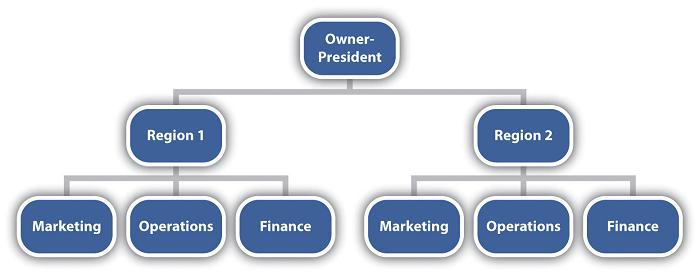Project organization structure is used to complete a project or task. The project manager has people from several functional departments such as production, finance, marketing and so on. Specialists are drawn to perform their respective roles in the total project. The project organization structure is derived not from some principles but from the job requirements. Project organization structure brings together people of different expertise for the completion of the project. As soon as the project is completed, the experts are returned to their original departments in the head office. For example, in a bridge construction project, the engineers, financial manager, human resources people and other related people are brought to the sit of the project where project organization, the structure and process, is developed. The people are organized and allocated specialized jobs by the Project manager who will be the top person managing the Continue reading
Management Basics
Geographical Organizational Structure
Geographical organizational structure involves grouping of the activities according to regional or geographical locations. The territorial divisions become a complete administrative unit to cater to the need of the localities. The Regional Manager will practically be the chief controller of his region. He is given full powers of managing his own region or zone. His office functions as a head office for all practical purposes. The functions pertaining to finance, marketing, personnel and production development of low-level employees are completely vested in the zonal office which has separate departments of these functions to guide and control the respective activities of the zone. The zonal office may have several divisional offices for executive functions. The area population and size of business in a zone will decide the number of divisional offices, their functional activities, and amount of authority and responsibility to be vested in the divisional managers. Continue reading
Product and Process based Functional Organizations
Product Functional Organizations Product functional organization establishes each product or group of related products as an autonomous unit in the framework of the organization. In product functional organization structure, each product has a separate identity although it functions under the control of the Chief Coordinating Executive. Each product department has several functions broadly divided into finance, marketing, personnel and production, which are also coordinated with the chiefs of the respective functions. The main advantage of product functional organization is qualitative production under the supervision of expert personnel to produce a particular product. For instance, a company may be producing modular kitchens, healthcare products, consumer electronics, computers, etc., which are managed by the respective engineering expert in the areas of their product. Overall control and supervision by higher executives is essential for the maximum utilization of existing resources without incurring wastage. It means rationalization is exercised with Continue reading
Functional Organization
Functional organization is technically called functional foreman-ship because the function itself becomes a supervisor and the employees automatically perform their respective duties. The emphasis of functional organization structure is on operations rather than on management. Functional organization is commonly used in business organizations. The spirit of organization, which involves grouping tasks together and allocating them to genuine employees is observed in functional organization. Functional sets like marketing, finance, production and personal are grouped systematically. Departments and sub departments are developed according to the requirements of the business. Functional organization is the basic building block or module from which other forms of organization are built. Functional organization is characterized by function, sub-goal emphasis, division of work, functional relationship, centralization and decentralization, span of control, divisionalization of product and regionalization. All employees are not equal; they have distinctive and special interests in different activities, while some of Continue reading
Line and Staff Organization
A line and staff organization is a mixture of the line as well as staff organization. Line organization points out direct vertical relationships, i.e., superior-subordinate relationship connecting the positions at each level. It forms a chain of command or hierarchy of authority on scalar principles. A line relationship is simply known as a relationship of authority between the superior and subordinates in a hierarchical arrangement. The direct line superior has control over his immediate subordinates. In this case, authority flows downward and accountability goes upward in a straight line. The work also flows in a direct line. The line offices are responsible for accomplishing basic objectives, so that they can issue orders and implement plans and policies with the help of their subordinates. They are authorized to maintain discipline. The line organization maintains direct communication from the higher to lower levels and vice versa. If it is useful for Continue reading
Features of Business Organizations
An organization is the association of persons for achieving certain objectives. An organization is a social system wherein its members try to achieve their private goals while achieving the organizational goals. The seemingly contradictory goals are resolved by effective organizational behavior. The organization has some objectives which are attained by organizing the activities of their member. An organization for business purposes is commonly known as a corporate body or a corporation or a company or formally established business unit. It is dynamic and ever changing as per the needs of society, its members, corporate objectives and environmental changes. Men form and develop organizations because they are unable to achieve the desired goals individually. They evolve different forms of organization according to their needs. An organization is a composition of people having different authorities and responsibilities to utilize existing resources for achieving the organizational objectives. Common Features of Business Organizations Continue reading



